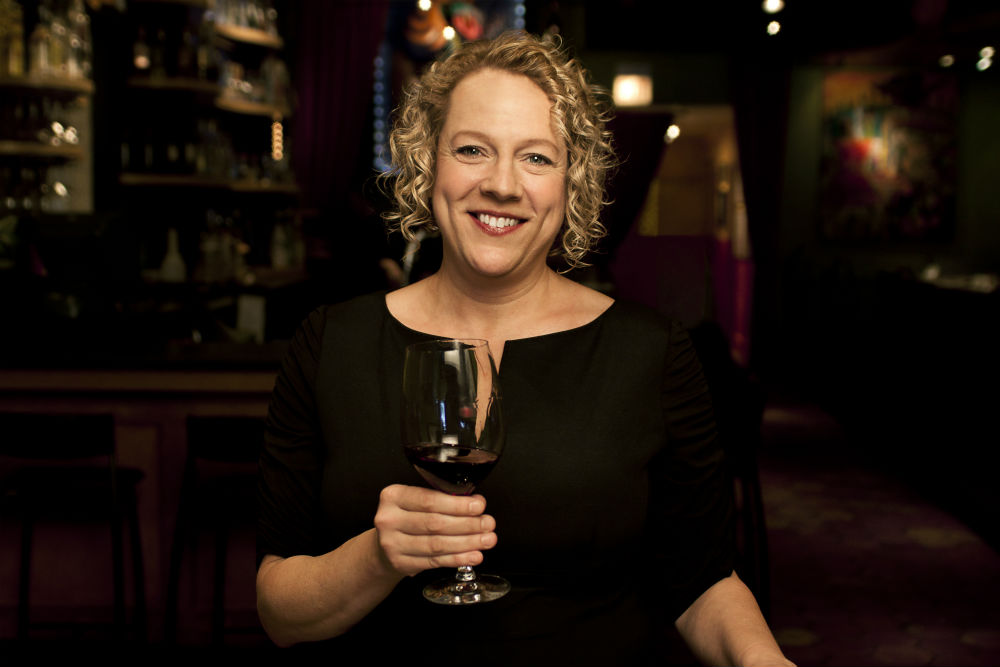Many of us have been there at one time or another: standing glassy-eyed in Target’s wine department—already late to a BYOB potluck or on a paper towel run at the end of a demoralizing Wednesday—and thinking to ourselves: How can I get out of here as fast as possible with a halfway decent wine?
Never fear, sommelier Jill Gubesch is here. Gubesch, the wine director for Frontera Grill and Topolobampo, says that the city’s best wine values can be found in its independent wine shops, where owners hand-select wines from mostly smaller producers. But she owns that it’s not always an option. “Sometimes I need a Targét,” she says. “We all do.”
We meet on a weekday afternoon at the surprisingly well-stocked Target in Logan Square (2656 N. Elston Ave.). In addition to a multi-aisle wine department and massive seasonal display near checkout, entire end caps show off sale-price California cabernet, and New Zealand white wines line the refrigerated cheese display in grocery. Hell, there’s even an entire aisle of personal care dedicated to what you might call “self-care” wines by checkout.
Such a dizzying array is enough to make this writer retreat guiltily to the nearest name-brand sauvignon blanc or lunge for the (second!) cheapest rioja on the shelf. Fortunately, Gubesch has a few savvier strategies for uncovering good-value wines in a hopeless, fluorescent-lit place.
Start with what you know.
There’s nothing wrong with gravitating toward the names you recognize, like Chateau St. Michelle, Beringer or Sterling, Gubesch says. These bottles often represent secondary labels for higher-end wines, so are likely a decent value. “Long-running wineries like Rodney Strong have also been paid for for years, so they can afford to charge a little less,” she says.
But fight the urge to grab that standby Kim Crawford sauvignon blanc. Instead, make it a jumping-off point to try something new. In this case, you already know that you like citrusy, herbaceous New Zealand sauvignon blanc, so try a different producer from the same region. “Joel Gott [California] and Brancott [Estate, New Zealand] do really great stuff at [affordable] prices,” Gubesch says.
Paying attention to the alcohol content and geography of the wines you already like can tell you a lot, too. Certain varietals like riesling and sauvignon blanc are already known for higher acid content. In very broad terms, the higher the alcohol content (“high” meaning 13.5% ABV and above), the lower the acidity, and vice versa. “The warmer the climate, the riper the grapes and typically the lower the acidity,” Gubesch says. So if you tend to go for unoaked chardonnay or less jammy pinot noir, you probably like higher-acid wines, which hail from cooler regions like Burgundy, France, or Monterey, California.
Look for regions known for great-value bottles.
When it comes to my tactic of grabbing the second-cheapest Spanish red on the shelf, turns out those instincts weren’t totally off. Even the wine-ignorant among us know by now that certain regions like Spain and South America offer great-value wines.
Our somm sleuth goes even more granular, however—noting that Mendoza, Argentina, and Chile (in particular the Colchagua region) boast the best South American values. “Chile benefits from natural barriers on all sides—the Andes, Patagonia, the high desert and the sea—that protect against climatic issues and blight like phylloxera,” she says. They have a hard time marketing and selling their wine, which also keeps the price low.
Similarly, when shopping for Spanish rioja, Gubesch says to look for garnacha grapes rather than the more famous tempranillo—because they’re marketed less and typically cheaper. The same goes for South African chenin blanc (unfortunately unavailable at our Target) and Washington State cabernets and merlots, which are often overshadowed by their bolder, pricier counterparts in Napa Valley and Sonoma, California. Target devotes considerable real estate in its red section to Washington winemaker Charles Smith—with $10-ish wines like Boom Boom Syrah, Chateau Smith cabernet and the “super delicious, super smooth,” Velvet Devil merlot—which is “so inexpensive, we've poured it at Xoco,” Gubesch says.
Above all, though, whether you’re in a big-box store or independent wine shop, wine should spark curiosity and excitement rather than dread and sweating. The worst thing that will happen is you’ll hate the wine. (Unfortunately, you can’t return it unless it’s unopened, as Target’s guest services told me, unless the bottle turns out to be corked.) Not unlike uncovering the sole unstained, unhemmed Calvin Klein jacket on the clearance rack at T.J. Maxx, bargain-wine shopping can be well worth it.
“You have to taste a lot of crap to get to those gems that are really delicious for 10 bucks a bottle,” Gubesch says. “But that’s the fun of the hunt.”
Cheat sheet: Five wines at Target worth adding to your cart
Root: 1 Heritage red blend (cabernet sauvignon, carmenere, syrah and petit verdot, $6.99) Labels like Root 1 demonstrate the inherent value of Chilean wines. “One of things Chile loves to promote is their carmenere, but it always has this kind of green bell peppery flavor,” Gubesch says. “I think their blends are much better.”
Allegrini 2011 Palazzo Della Torre red blend ($14.99) Allegrini is an Italian producer best-known for high-end amarone, a dry red blend of corvina and rondinella from the Valpolicella region, which produces some of the world’s best amarone. “In this wine they blend a little of that into sangiovese,” says Gubesch.
Rodney Strong 2014 Alexander Valley cabernet sauvignon ($10.99) This cooler-climate cab doesn’t have the same richness of a similar wine from Napa. “But Sonoma County Alexander Valley cab for eleven bucks?” Gubesch says. “That’s a steal.”
Sofia Coppola Blanc de Blanc sparkling wine ($15.99) When Gubesch wants to pop something easy on a weeknight, she goes for bubbles. “Sofia Coppola’s stuff is always fun and tasty,” she says.
Brancott Estate 2016 sauvignon blanc ($6.99) Try this crisp, citrusy white if you’re a fan of the ever-available Kim Crawford sauvignon blanc. “It’s so easy to drink and goes with everything,” Gubesch says.



